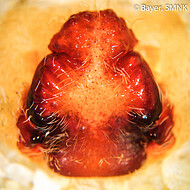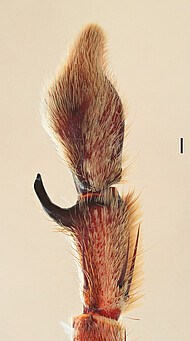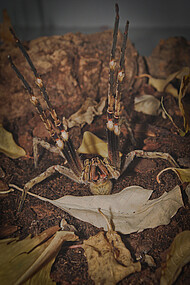Phoneutria - taxonomy
Species composition
After many years of uncertainty delimiting Phoneutria with regard to Ctenus the genus Phoneutria (Perty, 1833) was revised by Simo & Brescovit (2001). Based on their cladistic analysis Phoneutria is characterized by scopulae at the tarsi and tibia of the pedipalps, a median position of the epigynal pockets and simple copulatory ducts equal or shorter than the spermathecae - and also the defensive behavior erecting the body and front legs with lateral movements.
Simó & Brescovit listed five valid species: P. fera (Perty, 1833), P. nigriventer (Keyserling, 1891), P. boliviensis (F.O. Pickard-Cambridge, 1897), P. reidyi (F.O. Pickard-Cambridge, 1897) and the new species P. bahiensis (Simó & Brescovit, 2001). In their work they offer a key to the species. They synonymized P. keyserlingi (F.O. Pickard-Cambridge, 1897) and P. pertyi (F.O. Pickard-Cambridge, 1897) with P. nigriventer (Keyserling) and P. depilata (Strand) with P. boliviensis (F. O. Pickard-Cambridge). However, Hazzi & Hormiga (2021) revalidated P. depilata, based on morphological and molecular data, designated a neotype of P. boliviensis and presented diagnostic characters, distribution records and models for both species.
In 2007, Martins & Bertani treated the non-Amazonian species of the genus and offered a modified identification key. P. pertyi and P. keyserlingi were revalidated based on diagnostic characters of the genitalia and the new species P. eickstedtae was described.
In 2021, Hazzi & Hormiga separated Phoneutria depilata (Strand, 1909) from P. boliviensis (F.O. Pickard-Cambridge, 1897).
Actually Phoneutria is composed of the following nine species: P. bahiensis (Simo & Brescovit), P. boliviensis (F. O. Pickard-Cambridge), Phoneutria depilata (Strand, 1909), P. eickstedtae (Martins & Bertani), P. fera (Perty), P. keyserlingi (F. O. Pickard-Cambridge), P. nigriventer (Keyserling), P. pertyi (F. O. Pickard-Cambridge) and P. reidyi (F. O. Pickard-Cambridge).
Identification of species
The identification of Phoneutria is still not easy and misidentification or confusion with other spiders frequently occur. While the familiar belonging is relatively easy to recognize by the typical eye pattern (2-4-2), the differentiation of the genus may be a little bit more difficult.
The main diagnostic character of Phoneutria is the presence of dense prolateral scopulae on the pedipalp tibiae and tarsi in males and females (Mello-Leitão 1936, Simó & Brescovit 2001). In the field the characteristic defense display helps to identify Phoneutria among the ctenids. Further important are the genitalic characters of both sexes.
For a valid identification of the Phoneutria species the genitalia have to be examined and compared with the drawings and photos in Simó & Brescovit (2001) and Martins & Bertani (2007), however there is considerable variation observed and reliable and comparable drawings or photos of the epigynes of all species ares still lacking. The differentiation of P. boliviensis from P. depilata and the other Amazonian species P. fera and P. reidyi seems to be possible not only by the genitalia, but also two conspicuous lateral white-yellow bands in the frontal area of the prosoma (Hazzi & Hormiga 2021). P. depilata shows characteristic four conspicuous series of yellow dots on the venter of the opisthosoma.
Still, the general appearance (habitus) and the coloration of the spiders are less reliable, due to high variability, especially when the origin of the specimen is not exactly known and the colours of conserved specimens are faded.
The publication of Vetter & Hillebrecht (2008) offers some help in distinguishing Phoneutria species reaching Europe by cargo, especially from the harmless Cupiennius species. Jäger & Blick (2009) describe an imported female of P. boliviensis and offer helpful drawings of the epigyne and vulva (in German).
We offer here high quality photographs of the male palps (Photos: Thiago Gomes de Carvalho) and female genitalia (Photos: Dr. Steffen Bayer).





